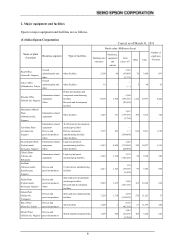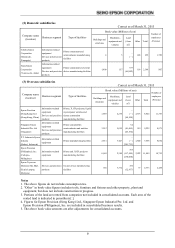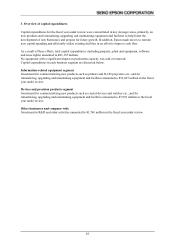Epson 2013 Annual Report Download - page 19
Download and view the complete annual report
Please find page 19 of the 2013 Epson annual report below. You can navigate through the pages in the report by either clicking on the pages listed below, or by using the keyword search tool below to find specific information within the annual report.
18
establish and operate an effective internal control system on a continuous basis, and since there are inherent
limitations to internal control systems, if the internal controls that Epson implements fail to function
effectively, or if there are deficiencies in internal controls over financial reporting or material weaknesses in
the internal controls, it might adversely affect the reliability of Epson’s financial reporting.
20. Epson is vulnerable to risks inherent in its tie-ups with other companies.
One of Epson’s business strategy options is to enter business tie-ups with other companies. However, the
parties may review the arrangements of tie-ups, and there is a possibility that tie-ups could be dissolved or
be subject to changes. There is also no assurance that the business strategy through the tie-ups will succeed
or contribute to Epson’s operating results exactly as expected.
21. Epson might be severely affected in the event of a natural or other disaster.
Epson has research and development, procurement, manufacturing, logistics, sales and services sites around
the globe. It is possible that the regions concerned could be affected by any number of unpredictable events,
such as a natural disaster, computer virus, outbreak of an influenza pandemic, leak of customer data, supply
chain disruption resulting from damage to parts suppliers, act of terrorism or war, and that these could
adversely affect Epson's operating results.
The central region of Nagano Prefecture, where Epson has sites for its primary businesses, has numerous
cities and towns designated as "Areas Requiring Enhanced Measures to Respond to Disasters" due to the
high risk of a large-scale disaster in the event of an earthquake in the Tokai region. Moreover, an active
fault line traces the Itoigawa Shizuoka geotectonic line through the middle of the Nagano Prefecture region.
The areas classifiable as Areas Requiring Enhanced Measures to Respond to Disasters were revised in April
2002, so Epson had to revise its earthquake-response policy, look into strengthening numerous buildings
that were not built to resist earthquakes, take measures to avoid losses of materials for important parts, and
create plans to prevent damage from earthquakes. Epson is also conducting other countermeasures such as
partially dispersing its manufacturing sites throughout other regions.
However, if a major earthquake occurs in the central Nagano Prefecture region, it is possible that, despite
these countermeasures, the effect on Epson could be extreme.
Although Epson is insured against losses arising from earthquakes, the scope of indemnification is limited.
22. Laws, regulations, or licenses and the like pose risks for Epson.
Epson is a multinational corporation with operations around the globe. In addition to strengthening its sales
and marketing activities targeting new customers, including public institutions, the Company is entering
new areas, such as the health and medical markets, where there may be stricter requirements for
compliance with laws and regulations. Epson has strengthened its compliance framework and strives to
ensure compliance with all statutory requirements through internal training and awareness-building
programs. However, a statutory violation or the risk of one, the introduction of stricter statues, or the
imposition of tougher laws by relevant authorities could potentially damage Epson's social credibility or
result in a large civil fine. Not only that but Epson could see constraints placed on its business activities or
see the cost of complying with these statutes increase. Any of these could have a adverse impact on Epson's
financial performance and future business development.
























